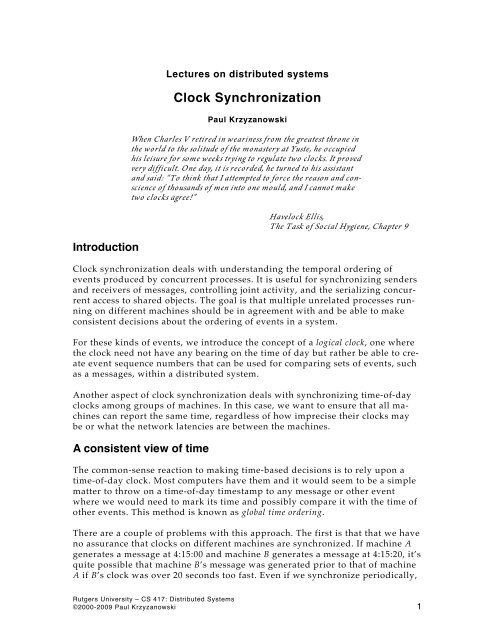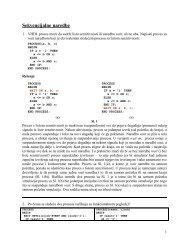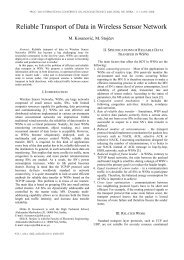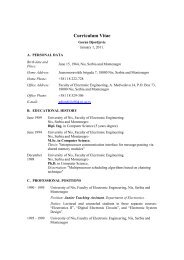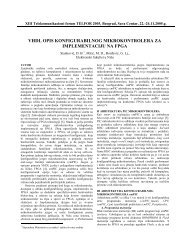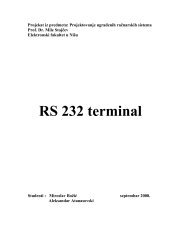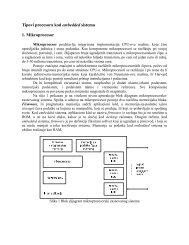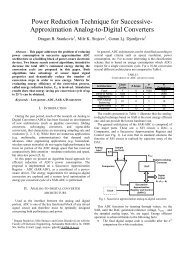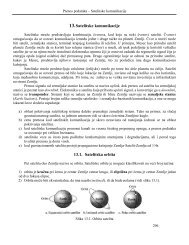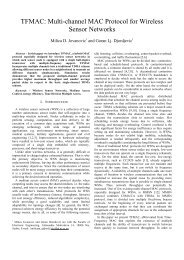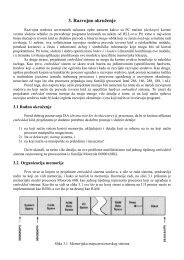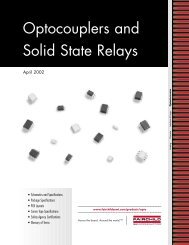Clock Synchronization - Computer Science
Clock Synchronization - Computer Science
Clock Synchronization - Computer Science
You also want an ePaper? Increase the reach of your titles
YUMPU automatically turns print PDFs into web optimized ePapers that Google loves.
Introduction<br />
Lectures on distributed systems<br />
<strong>Clock</strong> <strong>Synchronization</strong><br />
Paul Krzyzanowski<br />
When Charles V retired in weariness from the greatest throne in<br />
the world to the solitude of the monastery at Yuste, he occupied<br />
his leisure for some weeks trying to regulate two clocks. It proved<br />
very difficult. One day, it is recorded, he turned to his assistant<br />
and said: “To think that I attempted to force the reason and co nscience<br />
of thousands of men into one mould, and I cannot make<br />
two clocks agree!”<br />
Havelock Ellis,<br />
The Task of Social Hygiene, Chapter 9<br />
<strong>Clock</strong> synchronization deals with understanding the temporal ordering of<br />
events produced by concurrent processes. It is useful for synchronizing senders<br />
and receivers of messages, controlling joint activity, and the serializing concurrent<br />
access to shared objects. The goal is that multiple unrelated processes running<br />
on different machines should be in agreement with and be able to make<br />
consistent decisions about the ordering of events in a system.<br />
For these kinds of events, we introduce the concept of a logical clock, one where<br />
the clock need not have any bearing on the time of day but rather be able to create<br />
event sequence numbers that can be used for comparing sets of events, such<br />
as a messages, within a distributed system.<br />
Another aspect of clock synchronization deals with synchronizing time-of-day<br />
clocks among groups of machines. In this case, we want to ensure that all machines<br />
can report the same time, regardless of how imprecise their clocks may<br />
be or what the network latencies are between the machines.<br />
A consistent view of time<br />
The common-sense reaction to making time-based decisions is to rely upon a<br />
time-of-day clock. Most computers have them and it would seem to be a simple<br />
matter to throw on a time-of-day timestamp to any message or other event<br />
where we would need to mark its time and possibly compare it with the time of<br />
other events. This method is known as global time ordering.<br />
There are a couple of problems with this approach. The first is that that we have<br />
no assurance that clocks on different machines are synchronized. If machine A<br />
generates a message at 4:15:00 and machine B generates a message at 4:15:20, it’s<br />
quite possible that machine B’s message was generated prior to that of machine<br />
A if B’s clock was over 20 seconds too fast. Even if we synchronize periodically,<br />
Rutgers University – CS 417: Distributed Systems<br />
©2000-2009 Paul Krzyzanowski 1
<strong>Clock</strong> <strong>Synchronization</strong><br />
it’s quite possible (even likely) that the clocks may run at different speeds and<br />
drift apart to report different times.<br />
The second problem is that two events on two different systems may actually<br />
occur at exactly the same time (to the precision of the clock, at least) and thus be<br />
tagged with identical timestamps. If we have algorithms that compare messages<br />
to pick one over another and rely on them coming up with the same answer on<br />
all systems, we have a problem as there will be no unique way to select one<br />
message over another consistently<br />
Logical clocks<br />
Let’s again consider cases that involve assigning sequence numbers (“timestamps”)<br />
to events upon which all cooperating processes can agree. What matters<br />
in these cases is not the time of day at which the event occurred but that all<br />
processes can agree on the order in which related events occur. Our interest is in<br />
getting event sequence numbers that make sense system-wide. These clocks are<br />
called logical clocks.<br />
If we can do this across all events in the system, we have something called total<br />
ordering: every event is assigned a unique timestamp (number), every such timestamp<br />
is unique.<br />
However, we don’t always need total ordering. If processes do not interact then<br />
we don’t care when their events occur. If we only care about assigning timestamps<br />
to related (causal) events then we have something known as partial ordering.<br />
Leslie Lamport developed a “happens before” notation to express the relationship<br />
between events: a→b means that a happens before b. If a represents the<br />
timestamp of a message sent and b is the timestamp of that message being received,<br />
then a→b must be true; a message cannot be received before it is sent.<br />
This relationship is transitive. If a→b and b→c then a→c. If a and b are events<br />
that take place in the same process the a→b is true if a occurs before b.<br />
The importance of measuring logical time is in assigning a time value to each<br />
event such that everyone will agree on<br />
the final order of events. That is, if a→b<br />
then clock(a) < clock(b) since the clock<br />
(our timestamp generator) must never<br />
run backwards. If a and b occur on different<br />
processes that do not exchange<br />
messages (even through third parties)<br />
then a→b is not true. These events are<br />
said to be concurrent: there is no way<br />
that a could have influenced b.<br />
Consider the sequence of events depicted<br />
in Figure 1 taking place between<br />
Figure 1. Unsequenced event stamps<br />
Rutgers University – CS 417: Distributed Systems<br />
© 2000-2009 Paul Krzyzanowski 2
<strong>Clock</strong> <strong>Synchronization</strong><br />
three processes. Each event is assigned a timestamp by its respective process.<br />
The process simply maintains a global counter that is incremented before each<br />
event gets a timestamp.<br />
If we examine the timestamps from our global perspective, we can observe a<br />
number of peculiarities. Event g, the event representing the receipt of the message<br />
sent by event a, has the exact same timestamp as event a when it clearly<br />
had to take place after event a. Event e has an earlier time stamp (1) than the<br />
event that sent the message (b, with a timestamp of 2).<br />
Lamport’s algorithm remedies the situation by forcing a resequencing of timestamps<br />
to ensure that the happens before relationship is properly depicted for<br />
events related to sending and receiving messages. It works as follows:<br />
Each process has a clock, which can be a simple counter that<br />
is incremented for each event.<br />
The sending of a message is an event and each message carries<br />
with it a timestamp obtained from the current value of<br />
the clock at that process (sequence number).<br />
The arrival of a message at a process is also an event will also<br />
receive a timestamp – by the receiving process, of course. The<br />
process’ clock is incremented prior to timestamping the<br />
event, as it would be for any other event. If the clock value is<br />
less than the timestamp in the received message, the system’s<br />
clock is adjusted to the (message’s timestamp + 1). Otherwise<br />
nothing is done. The event is now timestamped.<br />
If we apply this algorithm to the same sequence of messages, we can see that<br />
proper message ordering among causally related events is now preserved (Figure<br />
2). Note that between every two events, the clock must tick at least once.<br />
Lamport's algorithm allows us to maintain proper time ordering among causally-related<br />
events. In summary, Lamport’s algorithm requires a monotonically<br />
increasing software counter for a “clock” that has to be incremented at least<br />
when events that need to be timestamped<br />
take place. These events<br />
will have the clock value, or “Lamport<br />
timestamp,” associated with<br />
them. For any two events, where<br />
a→b, L(a) < L(b) where L(x) represents<br />
the Lamport timestamp for<br />
event x.<br />
Lamport timestamps assure us that<br />
if there is a causal relationship between<br />
two events, then the earlier<br />
event will have a smaller time-<br />
Figure 2. Lamport sequenced event stamps<br />
Rutgers University – CS 417: Distributed Systems<br />
© 2000-2009 Paul Krzyzanowski 3
<strong>Clock</strong> <strong>Synchronization</strong><br />
stamp than the later event. Causality is achieved by successive events on one<br />
process or by the sending and receipt of messages on different processes. As defined<br />
by the happened-before relationship, causality is transitive. For instance,<br />
events a and f are causally related in Figure 2 (through the sequence a, b, e, f).<br />
Total ordering<br />
Note that it is very possible for multiple non-causal (concurrent) events to share<br />
identical Lamport timestamps (e.g., c, e, and h in Figure 2). This may cause confusion<br />
if multiple processes need to make a decision based on the timestamps of<br />
two events. The selection of a specific event may not matter if the events are<br />
concurrent but we want all the processes to be able to make the same decision.<br />
This is difficult if the timestamps are identical. Fortunately, there’s an easy remedy.<br />
We can create a total order on events by further qualifying them with identities<br />
of processes. We define a global logical timestamp (T i,i) where T i represents the<br />
local Lamport timestamp and i represents the process ID (in some globally<br />
unique way: for example, a concatenation of host address and process ID). We<br />
are then able to globally compare these timestamps and conclude that<br />
(T i,i) < (T j,j)<br />
if and only if<br />
T i < T j<br />
or T i = T j and i < j.<br />
There is no physical significance to the<br />
order since process identifiers can be<br />
arbitrary and do not relate to event ordering<br />
but the ability to ensure that no<br />
two Lamport timestamps are the same<br />
globally is helpful in algorithms that<br />
need to compare these timestamps.<br />
Figure 3 shows an example with a suffix<br />
of the process ID added to each<br />
timestamp. In real life, depending on<br />
the application, one may use a combination<br />
of thread ID, process ID, and IP<br />
address as a qualifier to the timestamp.<br />
Vector clocks: identifying concurrent events<br />
Figure 3. Totally ordered Lamport timestamps<br />
If two events are causally related and event e happened before event e’ then we<br />
know that L(e) < L(e’). However, the converse is not necessarily true. With Lamport’s<br />
algorithm, if L(e) < L(e’) we cannot conclude that e→e’. Hence, if we look<br />
at Lamport timestamps, we cannot conclude which pairs of events are causally<br />
related and which are not. One solution that has been proposed to deal with this<br />
Rutgers University – CS 417: Distributed Systems<br />
© 2000-2009 Paul Krzyzanowski 4
<strong>Clock</strong> <strong>Synchronization</strong><br />
problem is the concept of vector clocks (proposed by Mattern in 1989 and Fridge<br />
in 1991).<br />
A vector clock in a system of N processes is a vector of N integers. Each process<br />
maintains its own vector clock (V i for a process P i) to timestamp local events.<br />
Like Lamport timestamps, vector timestamps (the vector of N integers) are sent<br />
with each message. The rules for using vector clocks are:<br />
1. The vector is initialized to 0 at all processes:<br />
V i[j] = 0 for i,j = 1, …, N<br />
2. Before a process P i timestamps an event, it increments its element of the<br />
vector in its local vector:<br />
V i[i] = V i[i]+1<br />
3. A message is sent from process P i with V i attached to the message.<br />
4. When a process P j receives a vector timestamp t, it compares the two<br />
vectors element by element, setting its local vector clock to the higher of<br />
the two values:<br />
V j[i] = max(V j[i], t[i]) for i=1, …, N<br />
We compare two vector timestamps by defining:<br />
V = V’ iff V[j] = V’[j] for i=1, …, N<br />
V ≤ V’ iff V[j] ≤ V’[j] for i=1, …, N<br />
For any two events e, e’, if e→e’ then V(e) < V(e’). This is the same as we get<br />
from Lamport’s algorithm. With vector clocks, we now have the additional<br />
knowledge that if V(e) 0) but element 3 in a is<br />
less it is in e (0
<strong>Clock</strong> <strong>Synchronization</strong><br />
Physical clocks<br />
Most computers today keep track of the passage of time with a battery-backedup<br />
CMOS clock circuit, driven by a quartz resonator. This allows the timekeeping<br />
to take place even if the machine is powered off. When on, an operating system<br />
will generally program a timer circuit (a Programmable Interval Timer, or<br />
PIT, in older Intel architectures and Advanced Programmable Interrupt Controller,<br />
or APIC, in newer systems.) to generate an interrupt periodically (common<br />
times are 60 or 100 times per second). The interrupt service procedure simply<br />
adds one to a counter in memory.<br />
While the best quartz resonators can achieve an accuracy of one second in 10<br />
years, they are sensitive to changes in temperature and acceleration and their<br />
resonating frequency can change as they age. Standard resonators are accurate<br />
to 6 parts per million at 31°<br />
C, which corresponds to<br />
±½ second per day.<br />
The problem with maintaining<br />
a concept of time is when<br />
multiple entities expect each<br />
other to have the same idea<br />
of what the time is. Two<br />
watches hardly ever agree.<br />
<strong>Computer</strong>s have the same<br />
problem: a quartz crystal on<br />
one computer will oscillate<br />
at a slightly different frequency<br />
than on another<br />
computer, causing the clocks<br />
to tick at different rates. The<br />
phenomenon of clocks ticking<br />
at different rates, creat-<br />
clock<br />
A<br />
clock<br />
B<br />
Figure 5. <strong>Clock</strong> drift and clock skew<br />
skew = 4 seconds<br />
ing a ever widening gap in perceived time is known as clock drift. The difference<br />
between two clocks at any point in time is called clock skew and is due to both<br />
clock drift and the possibility that the clocks may have been set differently on<br />
different machines. Figure 5 illustrates this phenomenon with two clocks, A and<br />
B, where clock B runs slightly faster than clock A by approximately two seconds<br />
per hour. This is the clock drift of B relative to A. At one point in time (five seconds<br />
past five o'clock according to A's clock), the difference in time between the<br />
two clocks is approximately four seconds. This is the clock skew at that particular<br />
time.<br />
Compensating for drift<br />
We can envision clock drift graphically by considering true (UTC) time flowing<br />
on the x-axis and the corresponding computer’s clock reading on the y-axis. A<br />
perfectly accurate clock will exhibit a slope of one. A faster clock will create a<br />
slope greater than unity while a slower clock will create a slope less than unity.<br />
Rutgers University – CS 417: Distributed Systems<br />
© 2000-2009 Paul Krzyzanowski 6
<strong>Clock</strong> <strong>Synchronization</strong><br />
Suppose that we have a means of obtaining the true time. One easy (and frequently<br />
adopted) solution is to simply update the system time to the true time.<br />
To complicate matters, one constraint that we’ll impose is that it’s not a good<br />
idea to set the clock back. The illusion of time moving backwards can confuse<br />
message ordering and software development environments.<br />
If a clock is fast, it simply has to be made to run slower until it synchronizes. If<br />
a clock is slow, the same method can be applied and the clock can be made to<br />
run faster until it synchronizes. The operating system can do this by changing<br />
the rate at which it requests interrupts. For example, suppose the system requests<br />
an interrupt every 17 milliseconds (pseudo-milliseconds, really – the<br />
computer’s idea of what a<br />
millisecond is) and the clock<br />
runs a bit too slowly. The<br />
system can request interrupts<br />
at a faster rate, say<br />
every 16 or 15 milliseconds,<br />
until the clock catches up.<br />
This adjustment changes the<br />
slope of the system time and<br />
is known as a linear compensating<br />
function (Figure 6). After<br />
the synchronization period<br />
is reached, one can<br />
choose to resynchronize periodically<br />
and/or keep track<br />
of these adjustments and apply<br />
them continually to get a<br />
better running clock. This is<br />
analogous to noticing that<br />
your watch loses a minute<br />
every two months and mak-<br />
System clock, C<br />
ing a mental note to adjust the clock by that amount every two months (except<br />
the system does it continually). For an example of clock adjustment, see the<br />
UNIX System V man page for adjtime.<br />
Setting the time on physical clocks<br />
fast clock, dC/dt > 1<br />
a b<br />
ideal clock, dC/dt = 1<br />
linear compensating<br />
function applied<br />
UTC time, t<br />
With physical clocks, our interest is not in advancing them just to ensure proper<br />
message ordering, but to have the system clock keep good time. We looked at<br />
methods for adjusting the clock to compensate for skew and drift, but it is essential<br />
that we get the time first so that we would know what to adjust.<br />
One possibility is to attach a GPS (Global Positioning System) receiver to each<br />
computer. A GPS receiver will provide time within ± 1 msec. of UTC time and<br />
can be had for under US $40. Unfortunately, they rarely work indoors. Alternatively,<br />
if the machine is in the U.S., one can attach a WWV radio receiver to obtain<br />
time broadcasts from Boulder, Colorado or Washington, DC, giving accuracies<br />
of ± 3–10 msec., depending on the distance from the source. Another option<br />
Rutgers University – CS 417: Distributed Systems<br />
© 2000-2009 Paul Krzyzanowski 7<br />
skew<br />
Figure 6. Compensating for drift with a linear compensating<br />
function
<strong>Clock</strong> <strong>Synchronization</strong><br />
is to obtain a GOES (Geostationary Operational Environment Satellites) receiver,<br />
which will provide time within ± 0.1 msec. of UTC time. For reasons of economy,<br />
convenience, and reception, these are not practical solutions for every machine.<br />
Most machines will set their time by asking another machine for the time<br />
(preferably one with one of the aforementioned time sources). A machine that<br />
provides this information is called a time server.<br />
Cristianʼs algorithm<br />
The simplest algorithm for setting the time would be to simply issue a remote<br />
procedure call to a time server and obtain the time. That does not account for<br />
the network and processing delay. We can attempt to compensate for this by<br />
measuring the time (in local system time) at which the request is sent (T 0) and<br />
the time at which the response is received (T 1). Our best guess at the network<br />
delay in each direction is to assume that the delays to and from are symmetric<br />
(we have no reason to believe otherwise). The estimated overhead due to the<br />
network delay is then (T 1- T 0)/2. The new time can be set to the time returned by<br />
the server plus the time that elapsed since the server generated the timestamp:<br />
2<br />
T −<br />
Tnew = Tserver<br />
+<br />
1 0 T<br />
Suppose that we know the smallest time interval that it could take for a message<br />
to be sent between a client and server (either direction). Let's call this time T min.<br />
This is the time when the network and CPUs are completely unloaded. Knowing<br />
this value allows us to place bounds on the accuracy of the result obtained from<br />
the server. If we sent a request to the server at time T 0, then the earliest time<br />
stamp that the server could generate the timestamp is T 0 + T min. The latest time<br />
that the server could generate the timestamp is T 1 - T min, where we assume it<br />
took only the minimum time, T min, to get the response. The range of these times<br />
is: T 1 - T 0 - 2T min, so the accuracy of the result is:<br />
Errors are cumulative. If machine A synchronizes from a server B and gets an<br />
accuracy of ±5 msec but server B in turn got its time from server C with an accuracy<br />
of ±7 msec, the net accuracy at machine A is ±(5+7), or ±12 msec.<br />
€<br />
± T 1 − T 0<br />
2<br />
− T min<br />
Several time requests may be issued consecutively in the hope that one of the<br />
requests may be delivered faster than the others (e.g., it may be submitted during<br />
a time window when network activity is minimal). This can achieve improved<br />
accuracy.<br />
Cristian's algorithm suffers from the problem that afflicts all single-server algorithms:<br />
the server might fail and clock synchronization will be unavailable. It is<br />
also subject to malicious interference.<br />
Rutgers University – CS 417: Distributed Systems<br />
© 2000-2009 Paul Krzyzanowski 8
<strong>Clock</strong> <strong>Synchronization</strong><br />
Berkeley algorithm<br />
The Berkeley algorithm, developed by Gusella and Zatti in 1989, does not assume<br />
that any machine has an accurate time source with which to synchronize.<br />
Instead, it opts for obtaining an average time from the participating computers<br />
and synchronizing all machines to that average.<br />
The machines involved in the synchronization each run a time dæmon process<br />
that is responsible for implementing the protocol. One of these machines is<br />
elected (or designated) to be the master. The others are slaves. The server polls<br />
each machine periodically, asking it for the time. The time at each machine may<br />
be estimated by using Cristian's method to account for network delays. When all<br />
the results are in, the master computes the average time (including its own time<br />
in the calculation). The hope is that the average cancels out the individual<br />
clock's tendencies to run fast or slow.<br />
Instead of sending the updated time back to the slaves, which would introduce<br />
further uncertainty due to<br />
network delays, it sends each<br />
machine the offset by which its<br />
clock needs adjustment. The<br />
operation of this algorithm is<br />
illustrated in Figure 7. Three<br />
machines have times of 3:00, 3:25,<br />
and 2:50. The machine with the<br />
time of 3:00 is the server (master).<br />
It sends out a synchronization<br />
query to the other machines in the group. Each of these machines sends a timestamp<br />
as a response to the query. The server now averages the three timestamps:<br />
the two it received and its own, computing (3:00+3:25+2:50)/3 = 3:05.<br />
Now it sends an offset to each machine so that the machine's time will be synchronized<br />
to the average once the offset is applied. The machine with a time of<br />
3:25 gets sent an offset of -0:20 and the machine with a time of 2:50 gets an offset<br />
of +0:15. The server has to adjust its own time by +0:05.<br />
The algorithm also has provisions to ignore readings from clocks whose skew is<br />
too great. The master may compute a fault-tolerant average – averaging values<br />
from machines whose clocks have not drifted by more than a certain amount. If<br />
the master machine fails, any other slave could be elected to take over.<br />
Network Time Protocol (NTP)<br />
The Network Time Protocol [1991, 1992] is an Internet standard (version 3, RFC<br />
1305) whose goals are to:<br />
time?<br />
- Enable clients across the Internet to be accurately synchronized to UTC<br />
(universal coordinated time) despite message delays. Statistical techniques<br />
are used for filtering data and gauging the quality of the results.<br />
Rutgers University – CS 417: Distributed Systems<br />
© 2000-2009 Paul Krzyzanowski 9<br />
3:00<br />
3:25 2:50<br />
3:25 2:50<br />
+0:05<br />
server server<br />
time?<br />
-0:20<br />
3:00<br />
3:25 2:50<br />
Figure 7. Berkeley synchronization algorithm<br />
+0:15
<strong>Clock</strong> <strong>Synchronization</strong><br />
- Provide a reliable service that can survive lengthy losses of connectivity.<br />
This means having redundant paths and redundant servers.<br />
- Enable clients to synchronize frequently and offset the effects of clock<br />
drift.<br />
- Provide protection against interference; authenticate that the data is<br />
from a trusted source.<br />
The NTP servers are arranged into strata. stratum 1<br />
The first stratum contains the primary<br />
servers, which are machines that are<br />
stratum 2<br />
connected directly to an accurate time<br />
source. The second stratum contains the<br />
secondary servers. These machines are<br />
stratum 3<br />
synchronized from the primary stratum<br />
Figure 8. NTP synchronization subnet<br />
machines. The third stratum contains tertiary<br />
servers that are synchronized from the secondaries, and so on. Together, all<br />
these servers form the synchronization subnet (Figure 8).<br />
A machine will often try to synchronize with several servers, using the best of<br />
all the results to set its time. The best result is a function of a number of qualities,<br />
including: round-trip delay, consistency of the delay, round-trip error,<br />
server’s stratum, the accuracy of the server’s clock, the last time the server’s<br />
clock was synchronized, and the estimated drift on the server.<br />
Because a system may synchronize with multiple servers, its stratum is dynamic:<br />
it is based on the server used for the latest synchronization. If you synchronized<br />
from a secondary NTP server then you are in the third stratum. If,<br />
next time, you used a primary NTP server to synchronize, you are now in the<br />
second stratum.<br />
Machines synchronize in one of the following modes:<br />
- symmetric active mode: a host sends periodic messages regardless of the<br />
reachability state or stratum of its peer<br />
- symmetric passive: this mode is created when a system receives a message<br />
from a peer operating in symmetric active mode and persists as<br />
long as the peer is reachable and operating at a stratum less than or<br />
equal to the host. This is a mode where the host announces its willingness<br />
to synchronize and be synchronized by the peer. This mode offers<br />
the highest accuracy and is intended for use by master servers. A pair<br />
of servers exchanges messages with each other containing timing information.<br />
Timing data are retained to improve accuracy in<br />
synchronization over time.<br />
time source<br />
Rutgers University – CS 417: Distributed Systems<br />
© 2000-2009 Paul Krzyzanowski 10
<strong>Clock</strong> <strong>Synchronization</strong><br />
- procedure call mode: similar to Cristian’s algorithm; a client announces<br />
its willingness to by synchronized by the server, but not to synchronize<br />
the server.<br />
- multicast mode: intended for high speed LANs; relatively low accuracy<br />
but fine for many applications.<br />
All messages are delivered unreliably via UDP. In both the procedure call mode<br />
and symmetric mode, messages are exchanged in pairs. Each message has the<br />
following timestamps:<br />
T i-3: local time when previous NTP message was sent.<br />
T i-2: local time when previous NTP message was received.<br />
T i-1: local time when current NTP message was sent.<br />
The server notes its local time, T i. For each pair, NTP calculates the offset (estimate<br />
of the actual offset between two clocks) and delay (total transit time for<br />
two messages). In the end, a process determines three products:<br />
1. <strong>Clock</strong> offset: this is the amount that the local clock needs to be adjusted<br />
to have it correspond to a reference clock.<br />
2. Roundtrip delay: this provides the client with the capability to launch a<br />
message to arrive at the reference clock at a particular time; it gives us<br />
a measure of the transit time of the mesge to a particular time server.<br />
3. Dispersion: this is the “quality of estimate” (also known as filter dispersion)<br />
based on the accuracy of the server’s clock and the consistency of<br />
the network transit times. It represents the maximum error of the local<br />
clock relative to the reference clock.<br />
By performing several NTP exchanges with several servers, a process can determine<br />
which server to favor. The preferred ones are those with a lower stratum<br />
and the lowest total filter dispersion. A higher stratum (less accurate) time<br />
source may be chosen if the communication to the more accurate servers is less<br />
predictable.<br />
The Simple Network Time Protocol, SNTP (RFC 2030), is an adaptation of the Network<br />
Time Protocol that allows operation in a stateless remote procedure call<br />
mode or multicast mode. It is intended for environments when the full NTP implementation<br />
is not needed or is not justified. The intention is that SNTP be<br />
used at the ends of the synchronization subnet (high strata) rather than for synchronizing<br />
time servers.<br />
SNTP can operate in either a unicast, multicast, or anycast modes:<br />
- in unicast mode, a client sends a request to a designated server<br />
Rutgers University – CS 417: Distributed Systems<br />
© 2000-2009 Paul Krzyzanowski 11
<strong>Clock</strong> <strong>Synchronization</strong><br />
- in multicast mode, a server periodically sends a broadcast or multicast<br />
message and expects no requests from clients<br />
- in anycast mode, a client sends a request to a local broadcast or multicast<br />
address and takes the first response received by responding servers.<br />
From then on, the protocol proceeds as in unicast mode 1 .<br />
NTP and SNTP messages are both sent via UDP (there is no point in having time<br />
reports delayed by possible TCP retransmissions). The message structure contains:<br />
Leap indicator warns of impending leap second (last minute has either<br />
59, 60, or 61 seconds)<br />
Version number<br />
Mode symmetric active, symmetric passive, client, server,<br />
broadcast<br />
Stratum stratum<br />
Poll interval maximum interval between successive messages (power<br />
of 2)<br />
Precision 8-bit signed integer indicating the precision of the local<br />
clock, seconds to nearest power of two<br />
Root delay 32-bit number indicating total roundtrip delay to primary<br />
reference source (16 bit seconds, and 16 bits of<br />
decimal seconds)<br />
Root dispersion 32-bit number indicating the nominal error relative to<br />
the primary reference source<br />
Reference identifier identify the reference source – four character ASCII<br />
string. Possible sources are: local uncalibrated clock,<br />
atomic clock, NIST dial-up modem service, USNO modem<br />
service, PTB (Germany) dial-up modem service, Allouis<br />
(France) radio, Boulder (CO, USA) radio, LORAN-C radionavigation<br />
system, Global Positioning System (GPS),<br />
Geostationary Orbit Environment Satellite(GOES), & cetera.<br />
Reference timestamp<br />
(64 bits)<br />
Originate timestamp<br />
(64 bits)<br />
Receive timestamp<br />
(64 bits)<br />
time at which local clock was last set or corrected<br />
time at which request departed the client for the server<br />
time at which the request arrived at the server<br />
1 This is a somewhat different definition of anycast than that used in IPv6.<br />
Rutgers University – CS 417: Distributed Systems<br />
© 2000-2009 Paul Krzyzanowski 12
<strong>Clock</strong> <strong>Synchronization</strong><br />
Transmit timestamp<br />
(64 bits)<br />
time at which the reply departed the server<br />
Key identifier (32 bits) used if the NTP authentication scheme is implemented<br />
Message digest<br />
(128 bits)<br />
used if the NTP authentication scheme is implemented<br />
In unicast mode, the roundtrip delay and local offset are calculated as follows<br />
(from RFC2030):<br />
1. The client sets the transmit timestamp in the request to the time of<br />
day according to the client clock. (T 1).<br />
2. The server copies this field to the originate timestamp in the reply and<br />
sets the receive timestamp and transmit timestamps to the time of day<br />
according to the server clock (T 2, T 3).<br />
3. When the server reply is received, the client determines a destination<br />
timestamp as the time of arrival according to its clock (T 4).<br />
Timestamp name ID when generated<br />
originate timestamp T 1 time request sent by client<br />
receive timestamp T 2 time request received by<br />
server<br />
transmit timestamp T 3 time reply sent by server<br />
destination timestamp T 4 time reply received by client<br />
The roundtrip delay d is defined as:<br />
d = (T 4 – T 1 ) – (T 2 – T 3)<br />
Note that the delay estimates the time spent sending and receiving data over the<br />
network, and subtracts out the processing delay at the server. The local clock<br />
offset t is defined as:<br />
t = ((T 2 – T 1) + (T 3 – T 4)) / 2<br />
The client, after computing this offset, adds this amount to its clock.<br />
Rutgers University – CS 417: Distributed Systems<br />
© 2000-2009 Paul Krzyzanowski 13
<strong>Clock</strong> <strong>Synchronization</strong><br />
References<br />
Time, <strong>Clock</strong>s, and the Ordering of Events in a Distributed System, Leslie Lamport,<br />
Communications of the ACM, July 1978, Volume 21, Number 7, pp. 558-565.<br />
Distributed Systems: Concepts and Design, G. Coulouris, J. Dollimore, T. Kindberg,<br />
©1996 Addison Wesley Longman, Ltd.<br />
Distributed Operating Systems, Andrew Tanenbaum, © 1995 Prentice Hall.<br />
Modern Operating Systems, Andrew Tanenbaum, ©1992 Prentice Hall.<br />
RFC1305: Network Time Protocol version 3. This can be found in many locations.<br />
One place is http://www.faqs.org/rfcs/rfc1305.html<br />
RFC 2030: Simple Network Time Protocol version 4. This can be found in many<br />
places. One place is http://www.faqs.org/rfcs/rfc2030.html<br />
Rutgers University – CS 417: Distributed Systems<br />
© 2000-2009 Paul Krzyzanowski 14


